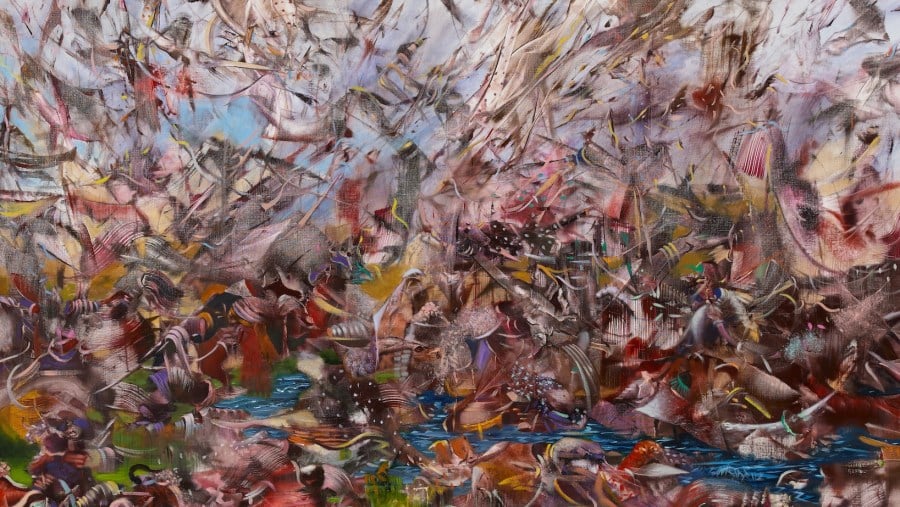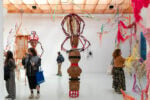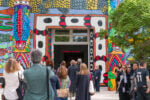The Sound of Painting

Nello storico Appartamento Padronale di Palazzo Saluzzo Paesana sei autorevoli protagonisti dello scenario artistico contemporaneo esplorano la componente dinamica del dipinto forgiando un linguaggio estremamente diacronico per interpretare l’arte a due dimensioni.
Comunicato stampa
Nello storico Appartamento Padronale di Palazzo Saluzzo Paesana sei autorevoli protagonisti dello scenario artistico contemporaneo esplorano la componente dinamica del dipinto forgiando un linguaggio estremamente diacronico per interpretare l'arte a due dimensioni. La sfera temporale del ritmo avvolge la superficie delle opere in mostra sino a determinare un movimento dal carattere narrativo, ridondante, surreale, materico o ancora scultoreo, tramite cui prende forma l'incontro estetico tra lo spazio pittorico e la natura provvisoria suono.
Ali Banisadr sublima la tragedia bellica della rivoluzione islamica e della contesa Iran-Iraq in atmosfere immaginarie gravide di memoria, nostalgia e caos. Il gesto dell'artista, per lo più ispirato alle antiche miniature persiane, si libera in alcune aree dall'accurata pratica figurativa celebrando con grandi pennellate danze astratte di colore. La guerra, il colonialismo, la corruzione, diventano i temi principi per un'inedita “poetica del conflitto”, elaborata attraverso un codice sinestesico che traduce il ricordo uditivo nella visione lirica di un tempo lontano, eppure perpetuo nel suo assillante rigenerarsi.
Ali Banisadr è nato nel 1976 a Tehran, vive e lavora a New York.
Mostre museali selezionate: The Metropolitan Museum of Art (New York); Miniature Museum of Contemporary Art at Haags Gemeente Museum (The Hague), Ensor en de hedendaagse kunst, Museum voor Schone Kunsten Gent at S.M.A.K (Ghent); Kunstraum Deutsche Bank (Salzburg); The Saatchi Gallery (London); Queens Museum of Art (Queens).
Definita dalla critica internazionale una delle pittrici più autorevoli della propria generazione, Inka Essenhigh scandaglia il territorio di confine che riunisce arte astratta, surreale, figurativa dando vita ad ambienti fiabeschi e personaggi dall'eleganza sinuosa. Nei dipinti della Essenhigh la cultura progressista dell'era industriale viene sublimata all'interno di un mondo pagano dove regnano il mito e la magia, quasi a voler suggerire la natura evasiva del sogno come unico ragionevole pharmakon post-moderno.
Inka Essenhigh è nata nel 1969 a Belfonte, vive e lavora a New York.
Mostre museali selezionate: Tomio Koyama Gallery (Kyoto); Victoria Miro Gallery (London); 303 Gallery (New York); Sint-Lukas Galerie (Brussels); Museum of Contemporary Art (Miami); The Fruitmarket Gallery (Edinburgh); Galleria Il Capricorno (Venice); First Center for the Visual Arts (Nashville); Center for Maine Contemporary Art (Rockport); Museum of Modern Art (New York); Ben Brown Fine Arts (London); Dayton Art Institute (Dayton).
Artista, musicista ed attivista di Chicago, Theaster Gates riscopre il potere evocativo dei materiali poveri generando un universo di installazioni, sculture e performance musicali che insieme concorrono al racconto non anacronistico di una storia politica profondamente segnata da violente oppressioni e continui tentativi di rivalsa. L'artista si impegna dunque ad investire di nuovo significato luogi abbandonati e oggetti ormai dismessi, sino a riconoscere nell'ermetismo formale di una pompa di idrante incorniciata un vero e proprio epitaffio per i diritti civili.
Theaster Gates è nato nel 1973 a Chicago, vive e lavora a Chicago.
Mostre museali selezionate: LA MOCA (Los Angeles); Milwaukee Art Museum (Milwaukee); Pulitzer Museum of Art (St. Louis); Kentucky Museum of Art and Craft (Louisville); Documenta 13 (Kassel); Smart Museum of Art (Chicago); Smithsonian American Art Museum (Washington D.C.); Contemporary Art Museum Houston (Houston); Sun Valley Center for the Arts (Sun Valley); Rubin Museum of Art (New York); Whitney Museum of American Art (New York); South Side Community Art Center (Chicago); Van Abbemuseum (Eindhoven).
Il vocabolario espressivo di Rashid Johnson trova le proprie radici nel concetto di "black experience", articolato nelle opere dell'artista grazie all'impiego costante di tropi e simbologie che ripercorrono la storia dei movimenti intellettuali afrioamericani dalla Harlem Renaissance al Back to Africa Movement. La maggior parte delle sculture testimonia una forte ibridazione con il medium pittorico, riconoscibile sia nei molteplici interventi presenti sui pannelli in legno - ove simboli marchiati a fuoco, sapone nero, cere e vernici invadono la superficie - che nei classici scaffali a parete densi di rimandi alla musica jazz e soul.
Rashid Johnson è nato nel 1977 a Chicago, vive e lavora a Brooklyn.
Mostre museali selezionate: Miami Art Museum (Miami); Museum of Contemporary Art (Chicago); Sculpture Center (Long Island City); Chrysler Museum of Art (Virginia); Rubell Family Collection (Miami); 54th Venice Biennale (Venice); Kunsthaus Glarus (Glarus); Palais des Arts et du Festival (Dinard); Chicago Cultural Center (Chicago).
Angel Otero indaga la sostanza costitutiva dell'opera pittorica delineando una narrativa sospesa tra la diacronia del ricordo e la natura sincronica dell'opera d'arte attraverso una chiave interpretativa echeggiante molteplici influenze (l'enfasi materica di David Hammons, l'espressionismo astratto di William De Kooning, o ancora l'energia cromatica di Joan Mitchell) la cui sintesi ultima si estrinseca in un approccio del tutto personale. Nei lavori dell'artista portoricano la “pelle” del dipinto (oil skin) nasce e prende forma indipendentemente dalla tela, che solo al termine dell'intero processo ospita sul proprio “corpo” infinite lenzuola di pittura.
Angel Otero è nato nel 1981 a San Juan, vive e lavora a Brooklyn.
Mostre museali selezionate: Chicago Cultural Center (Chicago); El Museo del Barrio (New York); Museum of Contemporary Art (Chicago); Prism (West Hollywood); Queens Museum Biennial (New York); Contemporary Art Museum (Raleigh); SCAD Museum of Art (Savannah).
Nell'opera di Tim Rollins e K.O.S le riflessioni di importanti autori classici e moderni come Eschilo, Martin Luther King, Aristofane, Franz Kafka, Omero, William Shakespeare, Dante, Gustave Flaubert, assumono una valenza iconografica che abbraccia la letteratura, la musica e l'arte visiva al fine di plasmare una prassi estetica dall'impronta altamente collaborativa le cui premesse culturali sono da rilevare nella necessità di un profondo cambiamento sociale; una trasformazione che parte dal sentire intimistico per trovare libero sfogo nella creatività condivisa.
Tim Rollins è nato nel 1955 nel Maine, vive e lavora a New York. I K.O.S. sono: Nelson Ricardo Savinon, Angel Abreu, Robert Branch, Jorge Abreu, Carlos Guevara, Eric Ramirez, Bryce Zachary, Logan Segwick, Ala Ebtekar.
Mostre museali selezionate: Museum für Gegenwartskunst (Basel); Galleria d´Arte Moderna e Contemporanea di Bergamo (Bergamo); Sarah Moody Gallery Universtity of Alabama (Tuscaloosa); Worcester Art Museum (Worcester); The Frye Art Museum (Seattle); The Rachofsky House (Dallas); Haggerty Museum of Art (Milwaukee); Kunstforum Ostdeutsche Galerie (Regensburg).
In the historic Master Apartment of Palazzo Saluzzo Paesana, six authoritative protagonists of the contemporary art scene explore the dynamic side of painting, forging an extremely diachronic language to interpret two-dimensional art. The temporal sphere of rhythm wraps the surface of the works in the show, triggering a movement of a narrative, reiterative, surreal, materic or even sculptural nature, through which the aesthetic encounter between pictorial space and the transient implication of sound takes place.
Ali Banisadr sublimates the tragedy of the Islamic revolution and the war between Iran and Iraq in imaginary atmospheres charged with memories, nostalgia and chaos. The artist’s gesture, primarily inspired by antique Persian miniatures, breaks free in certain areas from its painstaking figurative practice, celebrating with large brushstrokes abstract dances of colors. The war, colonialism and corruption become the major themes of an original “poetics of conflict”, developed through a synesthetic code that translates auditory memory into lyrical vision of a distant time, yet one that is perpetual in its obsessive regeneration.
Ali Banisadr was born in 1976 in Tehran, lives and works in New York.
Selected museum exhibitions: The Metropolitan Museum of Art (New York); Miniature Museum of Contemporary Art at Haags Gemeente Museum (The Hague), Ensor en de hedendaagse kunst, Museum voor Schone Kunsten Gent at S.M.A.K (Ghent); Kunstraum Deutsche Bank (Salzburg); The Saatchi Gallery (London); Queens Museum of Art (Queens).
Indicated by international critics as one of the most renowned painters of her generation, Inka Essenhigh explores the border territory between abstract, surreal and figurative art, giving rise to fairytale settings and personalities of sinuous elegance. In Inka Essenhigh’s paintings the progress-based culture of the industrial age is sublimated inside a pagan world where myth and magic hold sway, almost as if to suggest the escapism of dreams – “inner vision” – as the only reasonable postmodern pharmakon.
Inka Essenhigh was born in 1969 in Belfonte, lives and works in New York.
Selected museum exhibitions: Tomio Koyama Gallery (Kyoto); Victoria Miro Gallery (London); 303 Gallery (New York); Sint-Lukas Galerie (Brussels); Museum of Contemporary Art (Miami); The Fruitmarket Gallery (Edinburgh); Galleria Il Capricorno (Venice); First Center for the Visual Arts (Nashville); Center for Maine Contemporary Art (Rockport); Museum of Modern Art (New York); Ben Brown Fine Arts (London); Dayton Art Institute (Dayton).
The Chicago-based artist, musician and activist Theaster Gates rediscovers the evocative power of humble materials, generating a universe of installations, sculptures and musical performances that combine forces in a non-anachronistic narrative of a political history profoundly marked by violent oppression and ongoing attempts to overcome it. Gates sets out to bring new meaning to abandoned places and forgotten objects, to the point of revealing, in the formal hermeticism of a framed fire hose, a true epitaph of civil rights.
Theaster Gates was born in 1973 in Chicago, lives and works in Chicago.
Selected museum exhibitions: LA MOCA (Los Angeles); Milwaukee Art Museum (Milwaukee); Pulitzer Museum of Art (St. Louis); Kentucky Museum of Art and Craft (Louisville); Documenta 13 (Kassel); Smart Museum of Art (Chicago); Smithsonian American Art Museum (Washington D.C.); Contemporary Art Museum Houston (Houston); Sun Valley Center for the Arts (Sun Valley); Rubin Museum of Art (New York); Whitney Museum of American Art (New York); South Side Community Art Center (Chicago); Van Abbemuseum (Eindhoven).
The expressive vocabulary of Rashid Johnson finds its roots in the concept of "black experience", articulated in his works thanks to constant use of tropes and symbols that retrace the history of Afro-American intellectual movements, from the Harlem Renaissance to the Back to Africa Movement. Most of the sculptures reflect a sense of hybrid rapport with the medium of painting that can also be seen in the multiple interventions on wooden panels – where branded symbols, black soap, waxes and paints invade the surface – and in the classic wall shelves, dense with reminders of jazz and soul music.
Rashid Johnson was born in 1977 in Chicago, lives and works in Brooklyn.
Selected museum exhibitions: Miami Art Museum (Miami); Museum of Contemporary Art (Chicago); Sculpture Center (Long Island City); Chrysler Museum of Art (Virginia); Rubell Family Collection (Miami); 54th Venice Biennale (Venice); Kunsthaus Glarus (Glarus); Palais des Arts et du Festival (Dinard); Chicago Cultural Center (Chicago).
Angel Otero explores the constituent substance of the painted work, outlining a narrative suspended between the diachronism of memory and the synchronic nature of the artwork, through a key of interpretation that reflects multiple influences (the materic emphasis of David Hammons, the abstract expressionism of William De Kooning, or the chromatic energy of Joan Mitchell) whose final synthesis takes the form of an utterly personal approach. In the works of the Puerto Rican artist the "skin" of the painting (oil skin) takes form away from the canvas, which only at the end of the whole process hosts, on its "body", infinite sheets of paint.
Angel Otero was born in 1981 in San Juan, lives and works in Brooklyn.
Selected museum exhibitions: Chicago Cultural Center (Chicago); El Museo del Barrio (New York); Museum of Contemporary Art (Chicago); Prism (West Hollywood); Queens Museum Biennial (New York); Contemporary Art Museum (Raleigh); SCAD Museum of Art (Savannah).
In the work of Tim Rollins and K.O.S the reflections of important classical and modern writers like Aeschylus, Martin Luther King, Aristophanes, Franz Kafka, Homer, William Shakespeare, Dante and Gustave Flaubert take on an iconographic guise that embraces literature, music and visual art in order to shape an aesthetic praxis with a strong accent on collaboration, whose cultural underpinnings can be seen in the need for profound social change; a transformation that starts with inner sentiment and then breaks loose in shared creativity.
Tim Rollins was born in 1955 in Maine, lives and works in New York. Current member of K.O.S. are: Nelson Ricardo Savinon, Angel Abreu, Robert Branch, Jorge Abreu, Carlos Guevara, Eric Ramirez, Bryce Zachary, Logan Segwick, Ala Ebtekar.
Selected museum exhibitions: Museum für Gegenwartskunst (Basel); Galleria d´Arte Moderna e Contemporanea di Bergamo (Bergamo); Sarah Moody Gallery Universtity of Alabama (Tuscaloosa); Worcester Art Museum (Worcester); The Frye Art Museum (Seattle); The Rachofsky House (Dallas); Haggerty Museum of Art (Milwaukee); Kunstforum Ostdeutsche Galerie (Regensburg).



